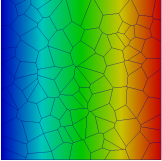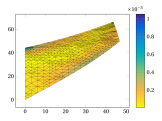Subproject
Novel finite element technologies for anisotropic media
Prof. Dr.-Ing habil. Jörg Schröder (Duisburg-Essen)
Prof. Dr.-Ing. habil. Dr. h.c. mult. Peter Wriggers (Hannover)
Prof. Dr.-Ing. habil. Daniel Balzani (Dresden)
Dipl.-Ing. Alex Kraus (Hannover)
Nils Viebahn, M.Sc. (Duisburg-Essen)

Abstract
Considering solid mechanics, a majority of the problems can be solved using the standard Galerkin method. Although this method is used as a standard tool for predicting the behavior of a variety of engineering structures, certain problems limit the applicability. In general, incompressible and/or anisotropic materials could lead to not well-posed formulations.
Finite-element formulations, which are available today using a purely volumetric-isochoric split, are not sufficient for anisotropic materials. Therefore, in this research project, the primary goal is to develop new finite-element formulations as a suitable basis for the stable calculation of complex materials in nonlinear applications. In order to achieve this goal new ideas have to be pursued since there is no obvious approach available at the moment to overcome these difficulties. Therefore, we follow three main strategies:
- Different approximations of the kinematic quantities entering the isotropic and anisotropic parts of the free energy function provide the possibility to relax the constraints arising from anisotropy. In this approach the structure of the polyconvex energy function is preserved.
- Special approximations of the minors of the deformation gradient lead to mixed formulations suitable for more general polyconvex strain energy functions. Thereby the ansatz spaces for the mixed variables approximating the minors are balanced.
- The VFEM, which was formulated so far only for small strain problems, is extended to large strains based on isotropic/anisotropic polyconvex strain energy functions. Thereby, the advantage to discretize non-convex regions using VFEM is exploited for the application to highly distorted deformed meshes.
As a common software development platform both workgroups, Essen and Hannover, will apply the AceGen environment which provides a flexible tool for the generation of efficient finite element code. This is in particular important because of the high complexity of the mixed forms and the large number of different variants to be considered.
- Mechanical-, civil- and aerospace engineering: Robust finite-element technologies will make highly predictible simulations available to various engineering applications and reduce development times and costs.
- Software industry: More reliable finite elements will help to build simulation environments that predict more realistically the behavior of various physical problems.
- Clinical medicine: The reliable prediction of the behavior of soft biological tissues will provide decision support for clinical doctors, e.g. for cardiovascular treatments.
- Biomedical engineering: The development of artificial implants, as e.g. stents, will be performed more efficiently based on stable numerical simulations, and the number of animal tests will be dramatically reduced.



